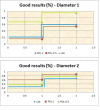Single Blind, Randomised Study Regarding the Treatment of the Telangiectasia of the Lower Limbs (C1EAP) Using Polidocanol 0,5%, 1%, and Nd:YAG Laser
- PMID: 32874686
- PMCID: PMC7445644
- DOI: 10.12865/CHSJ.46.02.07
Single Blind, Randomised Study Regarding the Treatment of the Telangiectasia of the Lower Limbs (C1EAP) Using Polidocanol 0,5%, 1%, and Nd:YAG Laser
Abstract
The treatment of leg telangiectasias could be done with liquid sclerotherapy or Nd:YAG laser. We evaluated randomly, in a simple blind, the efficacy of the treatment with 0,5% polidocanol (POL-0,5), 1% polidocanol (POL-1) and Nd:YAG laser (LAS) on 132 patient (264 limbs) with telangiectasia of the lower limbs with less than 2mm diameter (C1EAP). The main objective was to evaluate the efficacy of the sclerotherapy (chemical compared with Nd:YAG-LAS). Secondary objectives were: possible major complications (deep thrombosis, severe burns, ischemic complications, etc.), the percentage of the local complications, the cosmetic aspect-evaluated by both the patient and the doctor and the grade of discomfort of the patient during and after the procedure. Comparing the treatment with Nd:YAG laser (LAS), polidecanol-0.5% (POL-0.5), polidecanol 1% (POL-1), it was noticed that telangiectasias smaller than 1mm led to good and very good results in all the cases treated with Nd:YAG laser and the same outcome was obtained in one third of the subjects treated with POL-0.5, vs. 47.81% of patients treated with POL-1. When telangiectasias were larger than 1mm diameter, good and very good results occurred in 86.36% of patients treated with LAS and 100% of the cases treated with POL-0.5 and POL-1. In conclusion, we consider that leg telangiectasias can be treated with good results using Nd:YAG laser or sclerotherapy with polidocanol, Nd:YAG laser being reccomended for telangiectasia under than 1 mm diameter while sclerotherapy in larger vessels.
Keywords: Nd:Yag laser; Sclerotherapy; polidocanol; telangiectasia.
Copyright © 2014, Medical University Publishing House Craiova.
Figures






Similar articles
-
Comparative study in leg telangiectasias treatment with Nd:YAG laser and sclerotherapy.Exp Ther Med. 2019 Feb;17(2):1106-1112. doi: 10.3892/etm.2018.6985. Epub 2018 Nov 16. Exp Ther Med. 2019. PMID: 30679981 Free PMC article.
-
Nd:Yag laser combined with injection sclerotherapy in the treatment of reticular veins and telangiectasias (CLaCS method): A triple-blind randomized clinical trial comparing two sclerosing agents associated with same laser patterns.Phlebology. 2023 Apr;38(3):165-171. doi: 10.1177/02683555231153533. Epub 2023 Jan 19. Phlebology. 2023. PMID: 36657386 Clinical Trial.
-
Treatment of lower extremity telangiectasias in women by foam sclerotherapy vs. Nd:YAG laser: a prospective, comparative, randomized, open-label trial.J Eur Acad Dermatol Venereol. 2015 Mar;29(3):549-54. doi: 10.1111/jdv.12627. Epub 2014 Jul 28. J Eur Acad Dermatol Venereol. 2015. PMID: 25069999 Clinical Trial.
-
Transcutaneous laser treatment of leg veins.Lasers Med Sci. 2014 Mar;29(2):481-92. doi: 10.1007/s10103-013-1483-2. Epub 2013 Nov 13. Lasers Med Sci. 2014. PMID: 24220848 Review.
-
Laser-Assisted Control of Epistaxis in Hereditary Hemorrhagic Telangiectasia: A Systematic Review.Lasers Surg Med. 2020 Apr;52(4):293-300. doi: 10.1002/lsm.23147. Epub 2019 Aug 22. Lasers Surg Med. 2020. PMID: 31441079 Free PMC article.
References
-
- Van der Velden SK, Shadid NH, Nelemans PJ, Sommer A. How specific are venous symptoms for diagnosis of chronic venous disease. Phlebology. 2014;9(9):580–586. - PubMed
-
- Kahle B, Leng K. Efficacy of sclerotherapy in varicose veins-prospective, blinded, placebo-controlled study. Dermatol Surg. 2004;30(5):723–728. - PubMed
-
- Rabe E, Breu FX, Cavezzi A, Coleridge Smith P, Frullini A, Gillet JL, Guex JJ, Hamel-Desnos C, Kern P, Partsch B, Ramelet AA, Tessari L, Pannier F. European guidelines for sclerotherapy in chronic venous disorders. Phlebology. 2014;29(6):338–354. - PubMed
-
- Parsons ME. Sclerotherapy basics. Dermatol Clin. 2004;22(4):501–508. - PubMed
-
- Kern P, Ramelet AA, Wutschert R, Bounameaux H, Hayoz D. Single-blind, randomized study comparing chromated glycerin, polidocanol solution, and polidocanol foam for treatment of telangiectatic leg veins. Dermatol Surg. 2004;30(3):367–372. - PubMed
LinkOut - more resources
Full Text Sources
